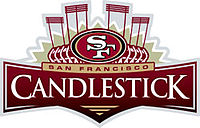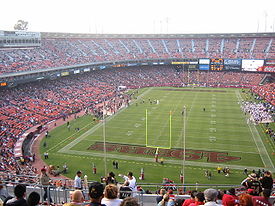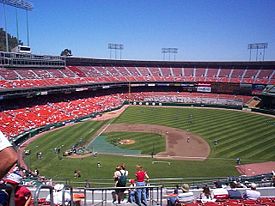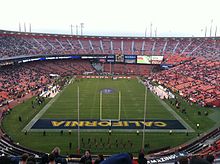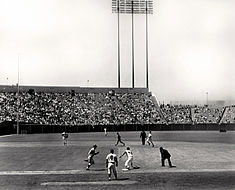- Candlestick Park
-
- For the tornado, see Candlestick Park tornado.
Candlestick Park The Stick
Former names Candlestick Park (1960–1995, 2008–present)
3Com Park at Candlestick Point (1995–2002)
San Francisco Stadium at Candlestick Point (2002–2004)
Monster Park (2004–2008)Location 602 Jamestown Avenue
San Francisco, California 94124Coordinates 37°42′49″N 122°23′10″W / 37.71361°N 122.38611°WCoordinates: 37°42′49″N 122°23′10″W / 37.71361°N 122.38611°W Broke ground August 12, 1958[1] Opened April 12, 1960 Owner The City and County of San Francisco Operator The City and County of San Francisco Surface Bluegrass (1960–1969, 1979–present)
AstroTurf (1970–1978)Construction cost $15 million USD
($111 million in 2011 dollars[2])Architect John Bolles General Contractor Charles Harney[3] Capacity 69,732[4] (Football) Tenants San Francisco Giants (MLB) (1960–1999)
San Francisco 49ers (NFL) (1971–Current)
Oakland Raiders (AFL) (1961)Candlestick Park (also commonly referred to as Candlestick or The Stick) is an outdoor sports and entertainment stadium located in San Francisco, California, in the Bayview Heights area. The stadium was originally built as the home of Major League Baseball's San Francisco Giants, who played there from 1960 until moving into Pacific Bell Park (since renamed AT&T Park) in 2000. Currently it is the home field of the San Francisco 49ers NFL team, who moved in for the 1971 season. Candlestick Park is set to be replaced by a new 49ers Stadium in 2015.
The stadium is situated at Candlestick Point on the western shore of the San Francisco Bay. Due to its location next to the bay, strong winds often swirl down into the stadium, creating unusual playing conditions. At the time of its construction in the late 1950s, the stadium site was one of the few pieces of land available in the city that was suitable for a sports stadium and had space for the 10,000 parking spaces promised to the Giants.
The surface of the field is natural bluegrass, but for nine seasons the stadium had artificial turf, from 1970 to 1978. A "sliding pit" configuration, with dirt cut-outs only around the bases, was installed in 1971, primarily to keep the dust down from the breezy conditions. Following the 1978 football season, the artificial turf was removed. Natural grass was re-installed before the 1979 baseball season.
Contents
Park history
When the New York Giants arrived in San Francisco in 1958, they played their home games at the old Seals Stadium at 16th and Bryant Streets. The City of San Francisco agreed to build a stadium if they moved from New York. Most of the land at Candlestick Point was purchased from Charles Harney, a local contractor. Harney purchased the land in 1952 for a quarry and industrial development. He made a profit of over $2 million when he sold the land for the stadium. Harney received a no-bid contract to build the stadium. The entire deal was the subject of a Grand Jury investigation in 1958. Ground was broken in 1958 for the new home of Major League Baseball's San Francisco Giants, who had moved west from New York following the end of the 1957 season. The Giants selected the name of Candlestick Park after a name-the-park contest on March 3, 1959. Prior to that, its construction site had been shown on maps as the generic Bay View Stadium.[5] It was the first modern baseball stadium, as it was the first to be built entirely of reinforced concrete.[6] Then Vice-President Richard Nixon threw out the first baseball on the opening day of Candlestick Park on April 12, 1960, and the Oakland Raiders played their 1961 American Football League season at Candlestick.
The Beatles played their last live commercial concert at Candlestick Park on August 29, 1966.
The stadium was enclosed during the winter of 1971–72 for the 49ers, with stands built around the outfield. The result was that the wind speed dropped marginally, but often swirled around throughout the stadium, and the view of the Bay was lost.
The stadium hosted two MLB All-Star Games (1961 and 1984), one National League Division Series (1997), three National League Championship Series (1971, 1987 and 1989), two World Series (1962 and 1989), and six NFC Championship games, the most notable being in January 1982 when Dwight Clark caught a game-winning touchdown pass from Joe Montana to lead the 49ers to their first Super Bowl (see "The Catch"). Candlestick Park was also home to dozens of commercial shoots as well as the location for the climatic scene in both the 1962 thriller Experiment in Terror and the 1973 Richard Rush comedy Freebie and the Bean. In February, 2011 scenes for "Contagion" staring Matt Damon, Kate Winslet and Jude Law were filmed at the stadium.
On October 17, 1989, the Loma Prieta earthquake (measuring 7.1 on the Richter Scale) struck San Francisco, minutes before Game 3 of the World Series was to begin at Candlestick. Remarkably, no one within the stadium was injured, although minor structural damage was incurred to the stadium. Al Michaels and Tim McCarver, who called the game for ABC, later credited the stadium's design for saving thousands of lives.[6] The World Series between the Giants and Oakland Athletics was subsequently delayed for 10 days, in part to give engineers time to check the stadium's (and that of nearby Oakland-Alameda County Coliseum) overall structural soundness. During this time, the 49ers moved their game against the New England Patriots on October 22 to Stanford Stadium, where they had won Super Bowl XIX several years before.
In 2000, the Giants moved to the new Pacific Bell Park (now called AT&T Park) in the South Beach neighborhood, leaving the 49ers as the sole professional sports team to use Candlestick. The final baseball game was played on Sept. 30, 1999, against the Los Angeles Dodgers, who won 9–4.
Currently, Candlestick Park is the only NFL stadium that began as a baseball-only facility and underwent extensive reconstruction to accommodate football, as evidenced by the stadium's unusual oblong design that leaves many seats on what was the right-field side of the stadium behind the eastern grandstand of the stadium during football games.
On September 3, 2011, Candlestick Park hosted the first college football game in its history with a neutral site game between the California Golden Bears and Fresno State Bulldogs (Cal was designated the "home" team).[7][8] This game was in San Francisco, because of the massive renovation and seismic retrofit at California's home stadium, California Memorial Stadium. The rest Golden Bears' home games in 2011 will be played at AT&T Park. Cal would go on to win the game 36-21. [9]
Reputation
As a baseball field, the stadium was best known for the windy conditions, damp air and dew from fog, and chilly temperatures. The wind often made life difficult for outfielders trying to catch fly balls, as well as for fans, while the damp grass further complicated play for outfielders that had to play in cold, wet shoes. Architect John Bolles designed the park with a boomerang-shaped concrete baffle in the upper tier to protect the park from wind. Unfortunately, it never worked. For Candlestick's first 10 seasons, the wind blew in from left-center and out toward right-center. When the park was expanded to accommodate the 49ers in 1971, it was thought fully enclosing the park would cut down on the wind. Instead, the wind swirled from all directions, and was as strong and cold as before.
During the first All Star Game of 1961 (one of two played in the park—the other was in 1984), Giants pitcher Stu Miller was blown off balance by a gust of wind and was charged with a balk. Two years later, wind picked up the entire batting cage and dropped it 60 feet (18 m) away on the pitcher’s mound while the New York Mets were taking batting practice.
The stadium also had the reputation as the coldest park in the major leagues. It was initially built with a radiant heating system of hot water pipes under the Lower Box seats in a space between the concrete and the ground. As the pipes were not embedded in the concrete it did not produce enough heat to offset the cold air. Both the city and the Giants balked at the cost of upgrading the system so it would work properly (e.g., to removing the seats and concrete, embedding larger pipes, and replacing the concrete and seats). As a result, the Giants played more day games than any Major League Baseball team except the Chicago Cubs, whose ballpark, Wrigley Field, did not have lights installed until 1988. Many locals, including Giants' broadcaster Lon Simmons, were surprised at the decision to build the park right on the bay, in one of the coldest areas of the city.[6]
The Giants eventually played on the reputation to bolster fan support with promotions such as awarding the Croix de Candlestick pin to fans who stayed for the duration of extra-inning night games. Among many less-than-flattering fan nicknames for the park were "North Pole," "Candlestink," "Candleshit," "Cave of the Winds," and "Windlestick." Older fans called it "The Dump" in honor of the former use of the land. Ironically, the Giants played their last game at Candlestick under blue skies with no fog and a game time temperature of a very non-Candlestick-like 82 degrees.
Giants owner Horace Stoneham visited the site as early as 1957 and was involved in the stadium's design from the outset. While he was aware of the weather conditions, he usually visited the park during the day--not knowing about the particularly cold, windy and foggy conditions that overtook it at night. Originally, Bolles' concrete baffle would have extended all the way to left field, which would have further reduced the prevailing winds. However, the size of the structure was reduced for cost savings. In 1962, Stoneham commissioned a study of the wind conditions. The study revealed that conditions would have been significantly improved had the park been built one hundred yards farther to the north and east.[10][6] However, this would have meant building it on fill, which is unstable during earthquakes. The stadium's location on the bedrock of Bayview Hill provided more stability.
The winds are intense in the immediate area of the park. Studies showed they were no more frequent than other parts of San Francisco but are subject to higher gusts. This is because of a hill immediately adjacent to the park. This hill, in turn, is the first topographical obstacle met by the prevailing winds arriving from the Pacific Ocean seven miles to the west. Arriving at Candlestick from the Pacific, these winds travel through what is known as the Alemany Gap before reaching the hill. The combination of ocean winds free-flowing to Candlestick, then swirling over the adjacent hill created the cold and windy conditions that were the bane of the Giants' 40-year stay on Candlestick Point. These same winds, of course, attract wind-surfers in droves to the wind-whipped San Francisco Bay coves south of Candlestick. It is indeed the wind and not the ambient air temperature that provides Candlestick's famed chill. The Giants' subsequent home, AT&T Park, is just one degree warmer, but is far less windy, creating a "warmer" (relatively speaking) effect. While the wind is a summer condition (hot inland, cool oceanside), winter weather is right in line with the rest of sea level Northern California (mild with occasional rain).
Attorney Melvin Belli filed a claim against the Giants in 1960 because his six-seat box, which cost him almost $1,600, was unbearably cold. Belli won in court, claiming that the "radiant heating system" advertised was a failure.[11]
Seating capacity
Baseball
- 43,765 (1960)
- 42,553 (1961-1964)
- 42,500 (1965-1970)
- 59,315 (1971-1988)
- 62,000 (1989-1992)
- 58,000 (1993-1999)
Football
- 61,185 (1971-1982)
- 61,413 (1983-1986)
- 64,252 (1987-1988)
- 65,701 (1989-1991)
- 66,513 (1992-1994)
- 70,207 (1995-1999)
- 69,732 (2000-present)
Other design flaws and irregularities
Candlestick was an object of scorn from baseball purists for reasons other than weather.
- Although originally built for baseball, foul territory was quite roomy. According to Simmons, nearly every seat was too far from the field even before the 1971 expansion.[6]
- While the Giants dugout and clubhouse were connected by a tunnel under the stands, the visitors dugout and clubhouse were not. The entrance to the visitors clubhouse was located close to the right field foul pole. Whenever visiting players, managers and/or coaches were ejected from a game, they had to walk down the right field foul line to the clubhouse—usually accompanied by a torrent of jeers, boos and catcalls from Giants fans. This feature was a carryover from the fourth and final incarnation of the Polo Grounds, the New York Giants home stadium in Harlem. At the Polo Grounds, the clubhouses for both teams were located beyond center field. Like the visitors dugout at Candlestick, both Polo Grounds dugouts had no attached facilities other than restrooms and drinking fountains.
- As with the radiant heating system in the grandstands, the heating systems in the dugouts were wholly inadequate. Players who had played for the Giants and for other National League teams complained that the visitors dugout was colder than the Giants dugout. This was due to two reasons: First, because the Giants dugout included a tunnel to the clubhouse, heat from the clubhouse flowed into the dugout. The second reason was due to the placement of the dugouts. The Giants dugout was located on the first base side which was on the south side of the stadium. The visitors dugout was located on the third base (west) side of the field.
Name changes
Candlestick Park was named for Candlestick Point, a point of land jutting into San Francisco Bay. Some think that Candlestick Point was named for the indigenous "candlestick bird" (Long-billed Curlew), once common to the point.[12] The book "California Geographic Names" lists Candlestick Point as being named for a pinnacle of rock first noted in 1781 by the De Anza Expedition. This pinnacle was also noted by the U.S Geodetic Survey in 1869. The pinnacle disappeared around 1920.
The rights to the stadium name were licensed to 3Com Corporation from September 1995 until 2002, for $900,000 a year. During that time, the park became known as 3Com Park at Candlestick Point, or, simply, 3Com Park. In 2002, the naming rights deal expired, and the park then became officially known as San Francisco Stadium at Candlestick Point. On Sept. 28, 2004, a new naming rights deal was signed with Monster Cable, a maker of cables for electronic equipment, and the stadium was renamed Monster Park. However, just over a month later, a measure passed in the November 2 election stipulated that the stadium name revert to Candlestick permanently after the contract with Monster expired in 2008.
The City and County of San Francisco had trouble finding a new naming sponsor due in part to the downturn in the economy, but also because the stadium's tenure as 3Com Park was tenuous at best. Many local fans were annoyed with the change and continued referring to the park by its original name, regardless of the official name. The Giants reportedly continued to call the stadium "Candlestick Park" in media guides, because the naming rights were initiated by the 49ers. Some even mocked the 3Com sponsorship. Chris Berman, for instance, usually called it "Commercial-Stick Park." Local fans sometimes called it "Dot-com Park." Freeway signs in the vicinity were changed to read "Monster Park" as part of an overall signage upgrade to national standards on California highways, but as of 2008, those signs have been changed back to Candlestick Park.
The name change also ended up being confusing for the intended branding purposes, as without the "Cable" qualifier in the official name, many erroneously thought the stadium was named for the Monster.com employment website or Monster Energy Drink, not the cable vendor.[13]
On August 10, 2007, San Francisco mayor Gavin Newsom announced that the playing field would be renamed Bill Walsh Field in honor of the former Stanford and 49ers coach, who died on July 30 that year, pending the approval of the city government. However the stadium will retain its current name as is contractually obligated.[14] Commentators still use this name occasionally, most recently when Jerry Rice's jersey was retired.
On September 18, 2009, Sports Illustrated's Peter King used the mock-combination name "Candle3Monsterstick" in reference to the many name changes the stadium has gone through.[15]
Despite numerous official and unofficial name changes over the history of the stadium and surrounding park/facilities, the stadium has been lovingly referred to as "the Stick" by many locals and die-hard fans since its original titling of Candlestick Park in 1960.
Future
Plans were underway to construct a new 68,000-seat stadium at Candlestick Point.[16] However, on November 8, 2006, the 49ers announced that they would abandon their search for a location in San Francisco and begin to actively pursue the idea of building a stadium in Santa Clara, California. As a result, San Francisco withdrew its bid for the 2016 Olympics on November 13, 2006, as its centerpiece stadium was lost. However, 49ers ownership continued to press forward; as a result of Santa Clara's approval of Measure J, construction of the new stadium was approved, and is slated to begin in 2012. It is unknown what will happen to Candlestick Park, although it will most likely be demolished once the 49ers move into the new stadium in 2015.
The Beatles' final concert
The Beatles gave their final full concert at Candlestick Park on August 29, 1966. Songs performed at the show were "Rock and Roll Music," "She's a Woman," "If I Needed Someone," "Day Tripper," "Baby's in Black," "I Feel Fine," "Yesterday," "I Wanna Be Your Man," "Nowhere Man," "Paperback Writer," and "Long Tall Sally." A rough recording of most of the concert was left unreleased, although the audio has leaked on to the internet. The recording cuts off during the last minute of the concert, interrupting "Long Tall Sally." Film of the concert was captured by a 15-year-old fan and featured in a documentary called The Unseen Beatles, [17] as well as by news teams from television stations from San Francisco and Sacramento.
References
- ^ Art Rosenbaum (August 12, 1958). "Bay City Banner". Los Angeles Times. http://pqasb.pqarchiver.com/latimes/access/444862522.html?dids=444862522:444862522&FMT=ABS&FMTS=ABS:AI&type=historic&date=Aug+12%2C+1958&author=&pub=Los+Angeles+Times&desc=BAY+CITY+BANTER&pqatl=google.
- ^ Consumer Price Index (estimate) 1800–2008. Federal Reserve Bank of Minneapolis. Retrieved December 7, 2010.
- ^ http://football.ballparks.com/NFL/SanFrancisco49ers/index.htm
- ^ http://prod.static.49ers.clubs.nfl.com/assets/docs/media-guide/2009/red-zone.pdf
- ^ "Pot Luck". St. Petersburg Times: p. 3-C. 1959-03-04. http://news.google.com/newspapers?id=KdMNAAAAIBAJ&sjid=9nYDAAAAIBAJ&pg=5404,2134654&dq=phillies&hl=en.
- ^ a b c d e Smith, Curt (2001). Storied Stadiums. New York City: Carroll & Graf. ISBN 0786711876.
- ^ http://espn.go.com/blog/ncfnation/post/_/id/42148/jeff-tedford-talks-fresno-state-ties
- ^ Crumpacker, John (August 26, 2011). "Fresno St. drawing better than Cal for opener". The San Francisco Chronicle. http://www.sfgate.com/cgi-bin/article.cgi?f=/c/a/2011/08/25/SP3V1KS3JA.DTL.
- ^ http://www.calbears.com/sports/m-footbl/stats/2011-2012/fscal.html
- ^ http://www.nd.edu/~nathaz/doc/tribute-JEC-wind-engineer.pdf
- ^ How Do Astronauts Scratch an Itch? by David Feldman
- ^ Supervisor wants Candlestick to stick
- ^ Gardner, Jim (November 27, 2005). "Fans unclear on main Monster in 49ers lineup". http://www.bizjournals.com/sanfrancisco/stories/2005/11/28/tidbits1.html.
- ^ 8,000 turn out at Monster Park to say goodbye to Bill Walsh
- ^ "Fascinating matchup in San Diego, more to watch this weekend". CNN. September 18, 2009. http://sportsillustrated.cnn.com/2009/writers/peter_king/09/18/week2/index.html. Retrieved April 28, 2010.
- ^ Official Site of the San Francisco 49ers - PR News
- ^ Beatles Last Show: Candlestick Park
External links
- Candlestick Park Official Site
- www.ballparks.phanfare.com photos and info about Candlestick park
- Monster Park -- Former Official Site
- 2004 aerial photograph showing football layout from USGS via Microsoft Research Maps (formerly TerraServer-USA)
Categories:- Defunct American Football League venues
- Defunct Major League Baseball venues
- National Football League venues
- Sports venues in the San Francisco Bay Area
- San Francisco 49ers stadiums
- San Francisco Giants stadiums
- Oakland Raiders stadiums
- Parks in San Francisco, California
- Buildings and structures completed in 1960
- Places associated with The Beatles
Wikimedia Foundation. 2010.

